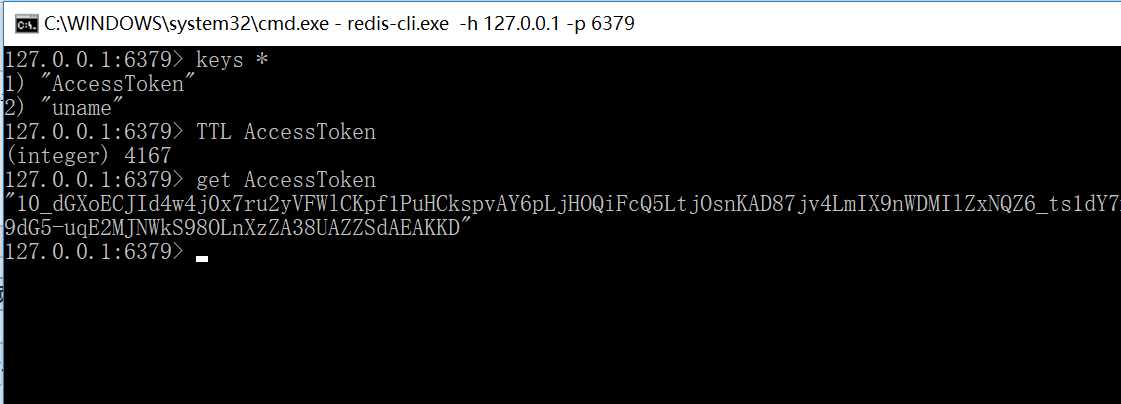前提是你的开发电脑安装和配置好了redis,如果没安装请看Window配置Redis环境和简单使用
<!-- https://mvnrepository.com/artifact/redis.clients/jedis --> <dependency> <groupId>redis.clients</groupId> <artifactId>jedis</artifactId> <version>2.9.0</version> </dependency>
#redis.host=127.0.0.1 redis.host=localhost redis.port=6379 redis.password=你的redis密码 redis.maxIdle=50 redis.maxTotal=100 redis.maxWaitMillis=3000 redis.testOnBorrow=true redis.timeout=5000
指定了redis属性配置文件的路径
<?xml version="1.0" encoding="UTF-8"?> <beans xmlns="http://www.springframework.org/schema/beans" xmlns:xsi="http://www.w3.org/2001/XMLSchema-instance" xmlns:util="http://www.springframework.org/schema/util" xmlns:p="http://www.springframework.org/schema/p" xsi:schemaLocation=" http://www.springframework.org/schema/beans http://www.springframework.org/schema/beans/spring-beans.xsd http://www.springframework.org/schema/util http://www.springframework.org/schema/util/spring-util.xsd"> <util:properties id="redisConfig" location="classpath:/config/redis.properties"></util:properties> <bean id="jedisPoolConfig" class="redis.clients.jedis.JedisPoolConfig"> <property name="maxIdle" value="#{redisConfig[‘redis.maxIdle‘]}" /> <property name="maxTotal" value="#{redisConfig[‘redis.maxTotal‘]}" /> <property name="maxWaitMillis" value="#{redisConfig[‘redis.maxWaitMillis‘]}" /> <property name="testOnBorrow" value="#{redisConfig[‘redis.testOnBorrow‘]}" /> </bean> <bean id="jedisPool" class="redis.clients.jedis.JedisPool"> <constructor-arg index="0" ref="jedisPoolConfig" /> <!-- 端口,默认6379 --> <constructor-arg index="1" value="#{redisConfig[‘redis.host‘]}" name="host" type="java.lang.String"/> <constructor-arg index="2" value="#{redisConfig[‘redis.port‘]}" name="port" type="int"/> <constructor-arg index="3" value="#{redisConfig[‘redis.timeout‘]}" name="timeout" type="int"/> <constructor-arg index="4" value="#{redisConfig[‘redis.password‘]}" name="password" type="java.lang.String"/> </bean> </beans>
最下方利用import标签引入redis的配置文件
<?xml version="1.0" encoding="UTF-8"?> <beans xmlns="http://www.springframework.org/schema/beans" xmlns:xsi="http://www.w3.org/2001/XMLSchema-instance" xmlns:context="http://www.springframework.org/schema/context" xmlns:mvc="http://www.springframework.org/schema/mvc" xsi:schemaLocation="http://www.springframework.org/schema/beans http://www.springframework.org/schema/beans/spring-beans.xsd http://www.springframework.org/schema/context http://www.springframework.org/schema/context/spring-context-4.0.xsd http://www.springframework.org/schema/mvc http://www.springframework.org/schema/mvc/spring-mvc-4.0.xsd"> <!-- 注解扫描包 --> <context:component-scan base-package="com.king.weixin"/> <!-- 开启注解 --> <mvc:annotation-driven/> <!-- 配置静态资源,直接映射到对应的文件夹,不被DispatcherServlet处理,3.04新增功能,需要重新设置spring-mvc-3.0.xsd --> <mvc:resources mapping="/img/**" location="/img/" /> <mvc:resources mapping="/js/**" location="/js/" /> <mvc:resources mapping="/css/**" location="/css/" /> <mvc:resources mapping="/html/**" location="/html/" /> <mvc:resources mapping="/tinymce/**" location="/tinymce/" /> <mvc:resources mapping="/upload/**" location="/upload/" /> <!-- 定义跳转的文件的前后缀 ,视图模式配置--> <bean id="viewResolver" class="org.springframework.web.servlet.view.InternalResourceViewResolver"> <!-- 这里的配置我的理解是自动给后面action的方法return的字符串加上前缀和后缀,变成一个 可用的url地址 --> <property name="prefix" value="/" /> <property name="suffix" value=".jsp" /> </bean> <!-- redis配置 --> <import resource="spring-redis.xml"/> </beans>
采用jedis获取redis资源和操作redis,添加值并且给值设置生命周期
public String addStringValue(String key, String value, int expireSeconds) { String result = null; Jedis jedis = null; try { jedis = jedisManager.getResource(); //result = jedis.set(key, value); result = jedis.set(key,value).toString(); if (expireSeconds != 0) { //EXPIRE key seconds 为给定 key 设置生存时间,当 key 过期时(生存时间为 0 ),它会被自动删除。 jedis.expire(key, expireSeconds); } } catch (Exception e) { e.printStackTrace(); } finally { jedisManager.returnResource(jedis); } return result; }
获取值得生命周期方法,ttl (key)
public long getStringValueTTLByKey(String key){ long result = 0; Jedis jedis = null; try { jedis = jedisManager.getResource(); //Redis TTL 命令以秒为单位返回 key 的剩余过期时间。 result = jedis.ttl(key); } catch (Exception e) { e.printStackTrace(); } finally { jedisManager.returnResource(jedis); } return result; }
在命令行查看redis中的所有key值和剩余生命周期,如下图可以使用keys * 查看所有缓存的key ,利用TTL key可以查看该key值对应对象的剩余生命周期

原文:https://www.cnblogs.com/wxjnew/p/9161730.html